Hydrogen Generation Market Research, 2031
The global hydrogen generation market size was valued at $136.3 billion in 2021, and hydrogen generation industry is projected to reach $262.0 billion by 2031, growing at a CAGR of 6.8% from 2022 to 2031.
Hydrogen plays a vital role in the chemicals and oil & gas industry. Hydrogen extracted from various processes is classified into three types—blue hydrogen, grey hydrogen, and green hydrogen. Grey hydrogen is hydrogen produced from fossil fuel resource where carbon capture and storage process is not implemented. Furthermore, this type of hydrogen releases carbon dioxide into environment as a byproduct.
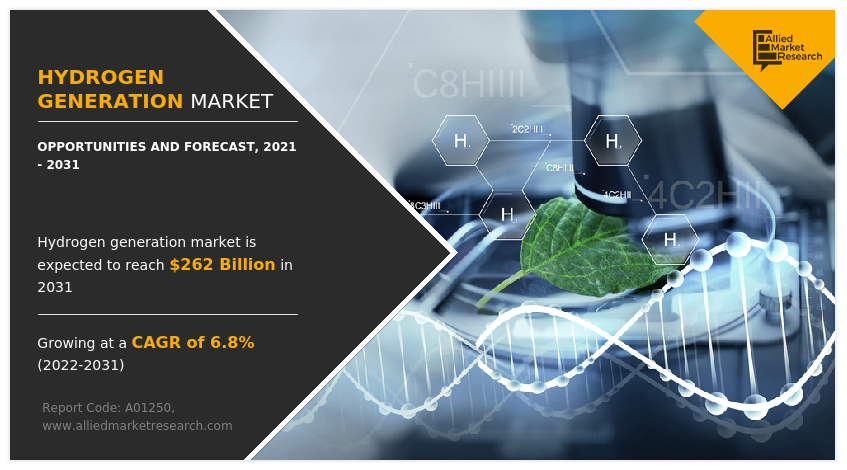
Blue hydrogen is an industry term for hydrogen produced from natural gas and supported by carbon capture and storage. The CO2 generated during the manufacturing process is captured and stored permanently underground. The result is low-carbon hydrogen that produces no CO2. Blue hydrogen is often touted as a low-carbon fuel for generating electricity and storing energy, powering cars, trucks and trains and heating buildings.
Green hydrogen is hydrogen generated by renewable energy or from low-carbon power. Green hydrogen has significantly lower carbon emissions than grey hydrogen, which is produced by steam reforming of natural gas, which makes up the bulk of the hydrogen market. Green hydrogen can help decarbonise sectors such as shipping and transportation, where it can be used as a fuel, as well as in manufacturing industries such as steel and chemicals, where it can constitute an important raw material as well as a fuel.
The major factors driving the hydrogen generation market growth is mostly due to ongoing unprecedented revolutions under the net zero emissions scenario, where global output of hydrogen is expected to reach 200 metric ton in 2030. In 2030, around 70% of the hydrogen production is projected to be done through low carbon technologies such as electrolysis. By 2050, the production of hydrogen is estimated to increase to about 500 metric tons. The increase in the investment of the government toward different technologies to improve the efficiency of hydrogen extraction is projected to drive the market growth. Energy efficiency, electrification, renewable energy, hydrogen and hydrogen based fuels, and carbon, capture, utilization and storage are some of the major technology pillars to decarbonize the world energy system.
The hydrogen generation market forecast is segmented on the basis of source, process, delivery mode, application and region. On the basis of source, it is classified into blue hydrogen, gray hydrogen, and green hydrogen. On the basis of process, the market is categorized into steam methane reforming, coal gasification, electrolysis, and other. On the basis of delivery mode, the market is bifurcated into captive and merchant. On the basis of application, the global hydrogen generation market is divided into chemical processing, transportation, petroleum recovery, power generation and others. Furthermore, the chemical processing segment is bifurcated into ammonia, methanol, and others. Region wise, the market is studied across North America, Europe, Asia-Pacific, and LAMEA. Presently, Asia-Pacific accounts for the largest hydrogen generation market share, followed by North America, and Europe.
The major companies profiled in this report include Linde Plc, Air Liquide, Cummins Inc., Uniper SE, Nel ASA, Siemens, Engine, ITM Power, Iberdrola, McPhy Energy S.A, Messer, Orsted A/S, Thyssenkrupp, Iwatani Corporation, Xebec Adsorption Inc., Ally Hi-Tech Co. Ltd, and Electrochaea GmbH. Rapid development of industrialization, modernization, and increase in awareness among the individuals regarding the environmental impact of fossil fuels fuel the demand for hydrogen. Additional growth strategies such as expansion of production capacities, acquisition, partnership and research & innovation in the detection technologies have led to attain key developments in the global hydrogen generation market trends.
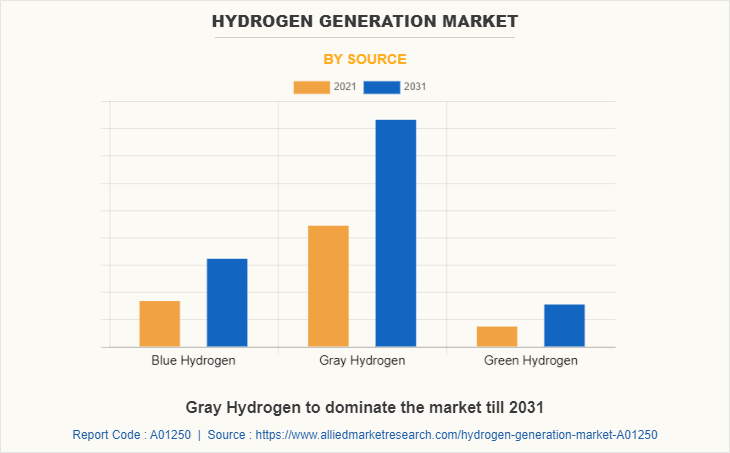
On the basis of source, the gray hydrogen segment dominates the global hydrogen generation market. Gray hydrogen is derived from natural gas and produced from fossil fuels, making it the least renewable form of hydrogen. Most of the hydrogen produced today is gray hydrogen. It is relatively inexpensive and commonly used in the chemical industry for making fertilizer and for refining oil. Rapid globalization, industrialization and increase in utilization of hydrogen in fuel cell operated vehicles are some factors likely to drive the gray hydrogen demand in hydrogen generation market. Rise in demand for gray hydrogen in the chemical industry is a prominent factor which augments the demand for gray hydrogen. Furthermore, two-thirds of the global hydrogen production is used in the chemical industry primarily for the synthesis of ammonia and methanol. The presence of above mentioned demand for hydrogen in various sectors is anticipated to provide ample opportunities for the development of the market.
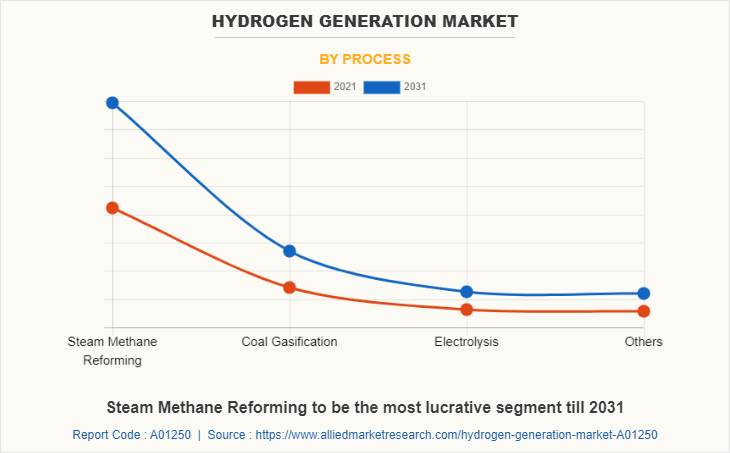
On the basis of process, the steam methane reforming segment dominates the global hydrogen generation market. Steam reforming is a process of extraction of hydrogen from the natural gas. This method is one of the cheapest sources of industrial hydrogen. This process consists of heating gases such as methane in the presence of steam and a catalyst to create endothermic reaction which is anticipated to further breakup methane molecule into carbon monoxide and hydrogen. The carbon monoxide is anticipated to further undergo water gas shift reaction to produce hydrogen gas. The rich fossil fuel resources of Middle East and African countries can be best opportunity for the growth of the market. The development of carbon capture technology during these years can also provide further opportunity for the growth of hydrogen production through steam reforming process. The above mentioned factors are expected to provide ample hydrogen generation growth opportunities for the development of the market.
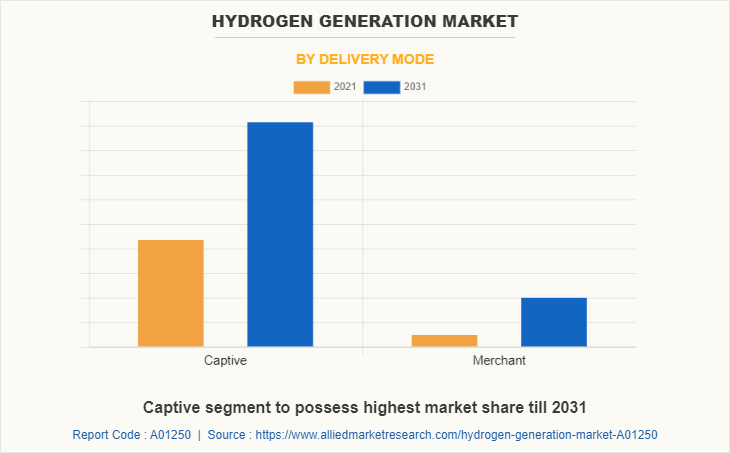
On the basis of delivery mode, the captive segment dominates the global hydrogen generation market. Hydrogen is an important chemical commodity in petroleum refining, ammonia production, and methanol production. For these industries, hydrogen is required on such a large scale that a majority of it is intentionally produced on site. This is called captive hydrogen delivery. The presence of demand for hydrogen in the production of variety of chemicals, and in petroleum industry in a bulk quantity is a major factor projected to drive the demand for captive mode hydrogen generation market. The increase in population and the industrialization across the globe has led to increase in the demand for the food products which led to the demand for ammonia which is a major raw material for the production of pesticides and others. The presence of above mentioned applications and demand for captive delivery mode hydrogen is anticipated to provide ample opportunities for the development of the market.
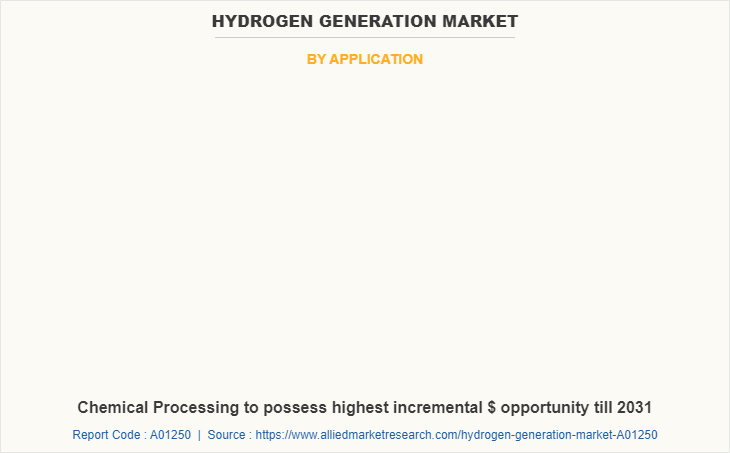
On the basis of application, the chemical processing segment dominates the global hydrogen generation market. Chemical processing is also one of the end user sector, where hydrogen is used extensively to produce various chemical products. The increase in demand for various ammonia fertilizers all over the world is an important factor for the growth of hydrogen in this segment. This increase in demand is projected to have positive impact over the large scale hydrogen generation devices. The increase in population and need for various chemical raw materials in various industries are providing opportunities for the growth of hydrogen generation market in this sector. The above mentioned factors are projected to provide ample opportunities for the development of the market during the forecast period.
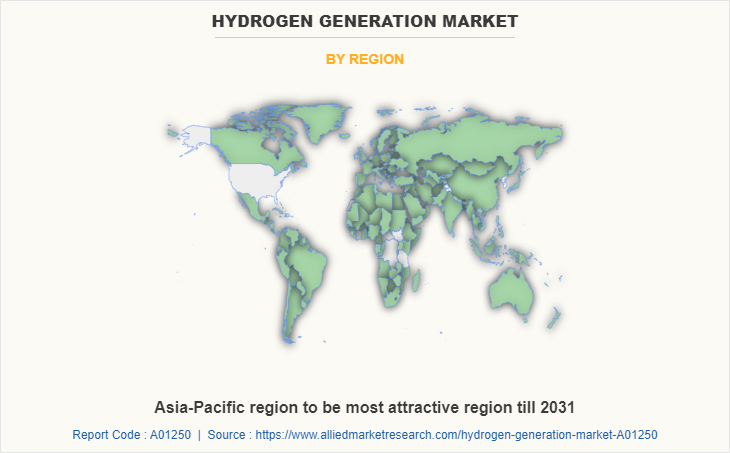
On the basis of region, Asia-Pacific is analyzed across China, Japan, India, South Korea, Australia, and the Rest of Asia-Pacific. Hydrogen plays an important role in the Asia-Pacific region as it can easily convert to and from electricity, and can be used to generate electricity for the future usage. It is used as raw materials to produce feed stock and products used in farming and mining sectors especially in Australia. Asia-Pacific is made up of many developing and under-developed countries, and is also the most populated region across the globe. It is also a home to a significant number of megacities and with the ever-increasing population. Most of the countries in this region depend on agriculture to develop the economy hence there is a huge demand for ammonia which is used as a major raw material in the agricultural chemicals. The increase in the utilization of ethanol blended fuel in this region and on-going reforms in India to improve the percentage of ethanol blend in the fuel is also projected to have positive impact on the market. The above mentioned policies and investments are major factors driving the growth of the market in this region during the forecast period.
Impact of Covid-19 on Hydrogen Generation Market
The global COVID-19 pandemic has negative impact on the hydrogen generation market. Outbreak of pandemic simultaneously affected households, business, financial institution, industrial establishments and infrastructure companies across the globe. The novel coronavirus has affected several economies and caused lockdown in many countries which has limited the growth of the market. The shutdown of industrial manufacturer led to the decline in the demand for solar related equipment in most of the countries across the world leading to decline in the growth of the hydrogen generation market. The decrease in utilization of power in the industrial facilities across the globe during the outbreak has a negative impact on the development of the market.
At the initial stage, demand for hydrogen significantly declined due to lockdowns. Furthermore, the supply of hydrogen was hampered, as major portion of the hydrogen is produced from natural gas reforming. However, governments of various countries across the world have eased lockdown restrictions. Therefore, there is steady rise in the manufacturing process. This is driving the demand for hydrogen in industrial applications. The trend is expected to continue during the forecast period.
Key Benefits For Stakeholders
- This report provides a quantitative analysis of the market segments, current trends, estimations, and dynamics of the hydrogen generation market analysis from 2021 to 2031 to identify the prevailing hydrogen generation market opportunities.
- The market research is offered along with information related to key drivers, restraints, and opportunities.
- Porter's five forces analysis highlights the potency of buyers and suppliers to enable stakeholders make profit-oriented business decisions and strengthen their supplier-buyer network.
- In-depth analysis of the hydrogen generation market segmentation assists to determine the prevailing market opportunities.
- Major countries in each region are mapped according to their revenue contribution to the global market.
- Market player positioning facilitates benchmarking and provides a clear understanding of the present position of the market players.
- The report includes the analysis of the regional as well as global hydrogen generation market trends, key players, market segments, application areas, and market growth strategies.
Hydrogen Generation Market Report Highlights
| Aspects | Details |
| Market Size By 2031 | USD 262 billion |
| Growth Rate | CAGR of 6.8% |
| Forecast period | 2021 - 2031 |
| Report Pages | 409 |
| By Source |
|
| By Process |
|
| By Delivery Mode |
|
| By Application |
|
| By Region |
|
| Key Market Players | Cummins Inc., Ally Hi-Tech Co. Ltd, ITM Power, Linde plc, Iberdrola, Xebec Adsorption Inc., Electrochaea GmbH, Siemens AG, Uniper SE, Messer, Orsted A/S, Iwatani Corporation, ThyssenKrupp, McPhy Energy S.A, L'Air Liquide S.A., Nel ASA |
| Other Key Market Players | Linde, Air Products &Chemicals, Uniper, Engie, Others |
Analyst Review
According to CXO perspective, the global hydrogen generation market is expected to witness increased demand during the forecast period, due to growing awareness among the people regarding the advantages of the hydrogen in transportation sector compared to conventional fuel, and its utilization in oil recovery.
Hydrogen is the cleanest form of fuel with zero-carbon emission, and upon combustion with oxygen, it provides the same energy as petrol or diesel, but with minimum pollution. Hydrogen fuel based internal combustion engines can be used in all kinds of vehicles. Blue hydrogen is hydrogen produced from natural gas by steam methane reforming, auto thermal reforming, and other process.
Increase in government initiatives to shift toward clean energy sources is another factor which is expected to boost the growth of the market. However, blue hydrogen, and grey hydrogen require natural gas and the production of blue hydrogen from natural gas produces carbon emissions. This factor is anticipated to hamper the development of the market. However, increase in government initiatives toward sustainable generation of hydrogen has led to increase in the investment from the private and government organizations to invest in green hydrogen production. The above mentioned factors are projected to have positive impact over the hydrogen generation market.
Rise in demand from chemical industries and hydrogen cell powered electric vehicles are the key factors boosting the Hydrogen generation market growth.
Ammonia industry is projected to increase the demand for Hydrogen generation Market
Linde Plc, Air Liquide, Cummins Inc., Uniper SE, Nel ASA, Siemens, Engine, ITM Power, Iberdrola, McPhy Energy S.A, Messer, Orsted A/S, Thyssenkrupp, Iwatani Corporation, Xebec Adsorption Inc., Ally Hi-Tech Co. Ltd, and Electrochaea GmbH.
The market value of Hydrogen generation in 2031 is expected to be $262.0 billion
The hydrogen generation market is segmented on the basis of source, process, delivery mode, application and region. On the basis of source, it is classified into blue hydrogen, gray hydrogen, and green hydrogen. On the basis of process, the market is categorized into steam methane reforming, coal gasification, electrolysis, and other. On the basis of delivery mode, the market is bifurcated into captive and merchant. On the basis of application, the global hydrogen generation market is divided into chemical processing, transportation, petroleum recovery, power generation and others. Furthermore, the chemical processing segment is bifurcated into ammonia, methanol, and others. Region wise, the market is studied across North America, Europe, Asia-Pacific, and LAMEA.
Increase in government initiatives to shift towards clean energy sources is the Main Driver of Hydrogen generation Market.
At the initial stage, demand for hydrogen significantly declined due to lockdowns. Furthermore, the supply of hydrogen was hampered, as major portion of the hydrogen is produced from natural gas reforming. However, governments of various countries across the world have eased lockdown restrictions. Therefore, there is steady rise in the manufacturing process. This is driving the demand for hydrogen in industrial applications. The trend is expected to continue during the forecast period.
Loading Table Of Content...



